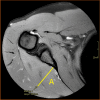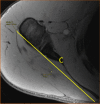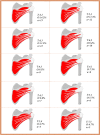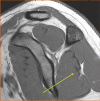The internal structure of the infraspinatus muscle: a magnetic resonance study
- PMID: 36348046
- PMCID: PMC9674736
- DOI: 10.1007/s00276-022-03042-2
The internal structure of the infraspinatus muscle: a magnetic resonance study
Abstract
Purpose: This study aimed to describe the internal structure of the infraspinatus muscle. A secondary aim was to explore differences in internal structure between genders, sides, and correlations to demographic data.
Methods: In total, 106 shoulder MRI examinations of patients between 18 and 30 years of age seeking care in 2012-2020 at The Sahlgrenska University Hospital in Gothenburg, Sweden were re-reviewed.
Results: The number of intramuscular tendons centrally in the infraspinatus muscle varied between 3 and 8 (median = 5). Laterally, the number of intramuscular tendons varied between 1 and 5 (median = 2). There was no difference in the median between the genders or sides. No correlations between the number of intramuscular tendons and demographic data were found. The muscle volume varied between 63 and 249 ml with a median of 188 ml for males and 122 ml for females. There was no significant difference in volume between the sides. The muscle volume correlated with body weight (Pearson's correlation coefficient, r = 0.72, p < 0.001) and height (r = 0.61, p < 0.001).
Conclusion: The anatomical variations of the infraspinatus muscle are widespread. In the medial part of the muscle belly, the number of intramuscular tendons varied between 3 and 8, while the number of intramuscular tendons laterally varied between 1 and 5. Results of our study may help to understand the internal structure of the infraspinatus muscle and its function in shoulder stabilization.
Keywords: Anatomy; Infraspinatus muscle; Magnetic resonance imaging; Rotator cuff.
© 2022. The Author(s).
Conflict of interest statement
The authors declare no competing interests.
Figures
















Similar articles
-
Surgical rotator cuff muscle biopsies: are they representative of overall muscle quality?J Shoulder Elbow Surg. 2021 Aug;30(8):1811-1816. doi: 10.1016/j.jse.2020.09.045. Epub 2020 Nov 25. J Shoulder Elbow Surg. 2021. PMID: 33248273
-
Tears at the myotendinous junction of the infraspinatus: ultrasound findings.Diagn Interv Imaging. 2015 Apr;96(4):349-56. doi: 10.1016/j.diii.2014.11.009. Epub 2015 Feb 10. Diagn Interv Imaging. 2015. PMID: 25680675
-
Partial-Thickness Rotator Cuff Tear by Itself Does Not Cause Shoulder Pain or Muscle Weakness in Baseball Players.Am J Sports Med. 2019 Dec;47(14):3476-3482. doi: 10.1177/0363546519878141. Epub 2019 Oct 14. Am J Sports Med. 2019. PMID: 31609639
-
Cross-Sectional Area of the Rotator Cuff Muscles in MRI - Is there Evidence for a Biomechanical Balanced Shoulder?PLoS One. 2016 Jun 23;11(6):e0157946. doi: 10.1371/journal.pone.0157946. eCollection 2016. PLoS One. 2016. PMID: 27336464 Free PMC article.
-
Utility of sonoelastography for the evaluation of rotator cuff tendon and pertinent disorders: a systematic review and meta-analysis.Eur Radiol. 2020 Dec;30(12):6663-6672. doi: 10.1007/s00330-020-07059-2. Epub 2020 Jul 14. Eur Radiol. 2020. PMID: 32666319
Cited by
-
A Cadaveric Study of the Rotator Cable: Interrogating the Suspension Bridge Model.Cureus. 2024 Oct 3;16(10):e70795. doi: 10.7759/cureus.70795. eCollection 2024 Oct. Cureus. 2024. PMID: 39372380 Free PMC article.
References
-
- Campbell MJ. Medical statistics (electronic book): a textbook for the health sciences. 5. Hoboken: Wiley; 2020.
-
- Centralbyrån S. Undersökningarna av levnadsförhållanden (ULF) Stockholm: Statistikmyndigheten; 2020.
MeSH terms
LinkOut - more resources
Full Text Sources

